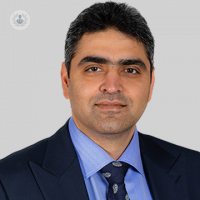Biceps tendon rupture at the elbow: When is surgical treatment required?
Written in association with:A tear of the biceps tendon at the elbow, whether partial or complete, can cause a significant and lasting impact on the arm’s strength and function if not treated correctly. We invited highly esteemed consultant orthopaedic surgeon Mr Abhinav Gulihar to share his expert insight on how this type of injury most often occurs and what is involved in the process of assessment and treatment.

How does this type of injury usually occur?
The biceps muscle extends from the socket of the shoulder joint to the radius bone just beyond the elbow. A tear of the distal (far end) of the biceps occurs when the tendon is forcefully pulled off the radius bone. This usually occurs during heavy lifting but can also occur during sporting activity such as boxing. This injury is more likely to occur in people older than thirty-five to forty years of age where the tendon that has been weakened by wear and tear is suddenly overloaded.
What are the different types of biceps tendon tears?
Biceps tendon tears can be partial or complete. Partial tears involve tearing of only a part of the tendon. As the tendon is not completely pulled away from the bone, the shape of the muscle does not change. There is often acute pain followed by bruising and swelling. Symptoms improve gradually over several weeks and physiotherapy helps to regain full strength.
Surgery is only required if the majority of the tendon is torn and the shape of the muscle has changed. When the tendon is completely torn, the tendon gets pulled away from the bone and the shape of the muscle changes. The entire muscle gets pulled up into the upper arm followed by development of swelling, bruising and weakness.
How is a biceps tendon tear at the elbow diagnosed?
A biceps tendon tear can often be diagnosed clinically when there is a clear history of acute pain and a snapping sensation whilst lifting something heavy or during sporting activity where the elbow has been pushed downwards forcefully. A change in shape of the biceps muscle, the presence of bruising or swelling and a positive “hook” test on clinical examination confirm the diagnosis. An ultrasound scan performed by an experienced musculoskeletal radiologist, or an MRI scan is often requested to assess how far the biceps tendon has pulled away from the bone.
How is a distal biceps tendon tear treated?
Partial tears can often be treated with pain relief and initial rest followed by physiotherapy. Non operative treatment is also appropriate for less active or older patients where mild weakness might not be noticeable.
High grade partial tears or complete tears often require surgery as non-operative treatment can result in weakness and aching especially during twisting movements of the forearm. The operation is best performed within the first 3-4 weeks after the injury as delay can result in the tendon being pulled further away from the bone. Results of surgery are generally good with recovery of full function in 4-6 months.
If you would like to schedule a consultation with Mr Gulihar, you can do so by visiting his Top Doctors profile.


